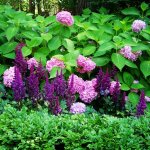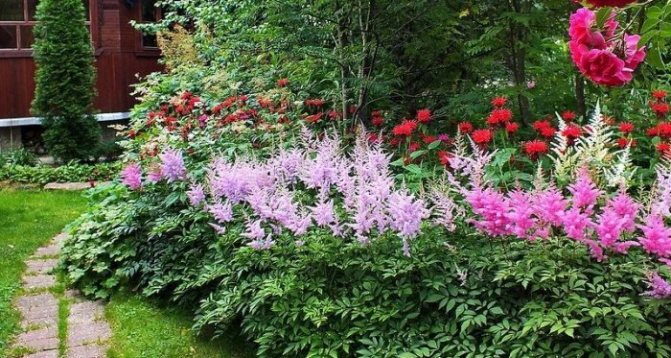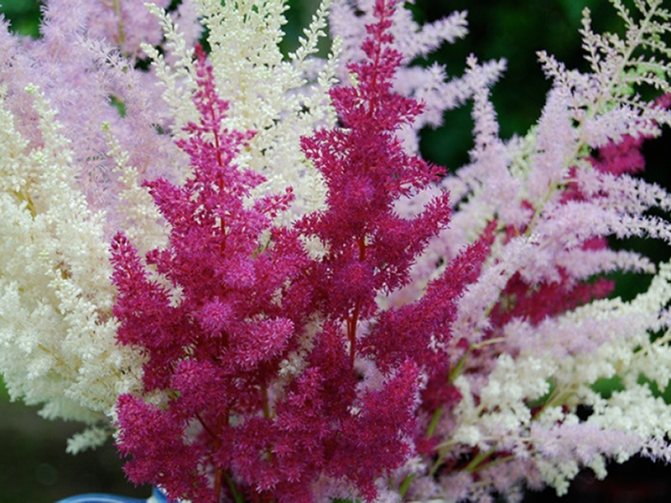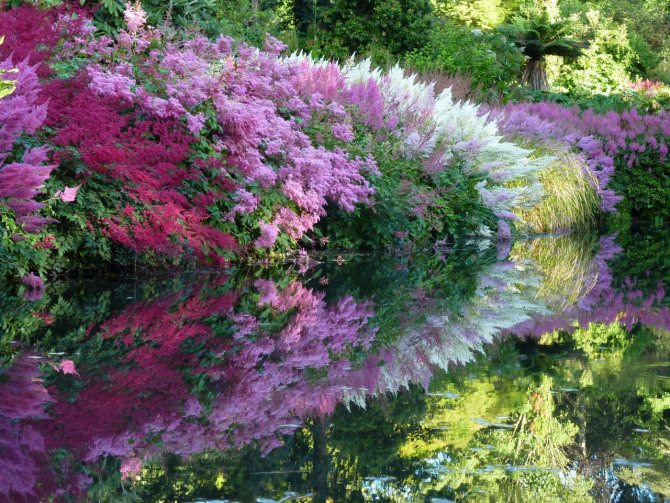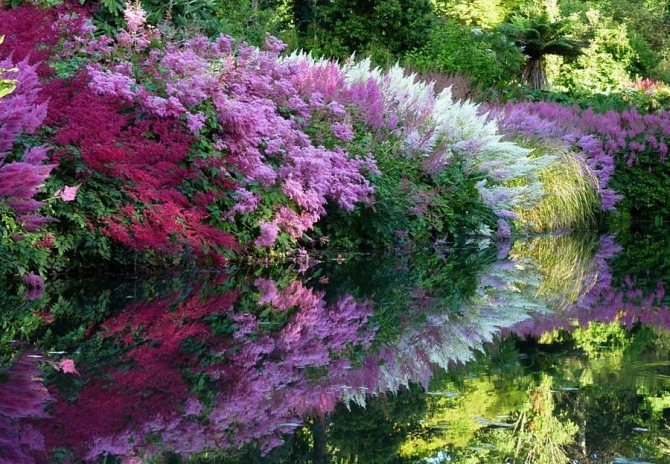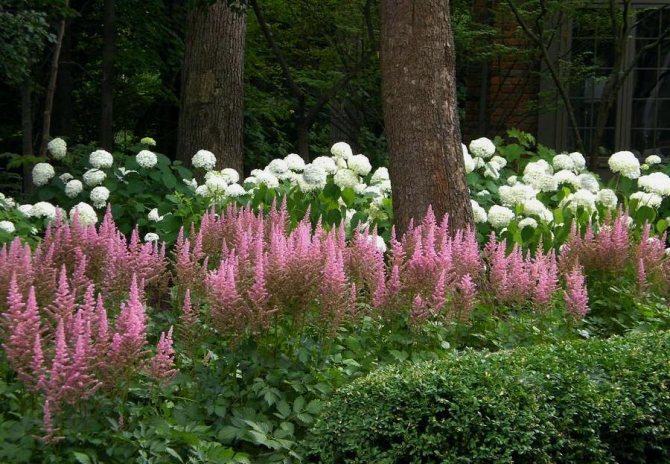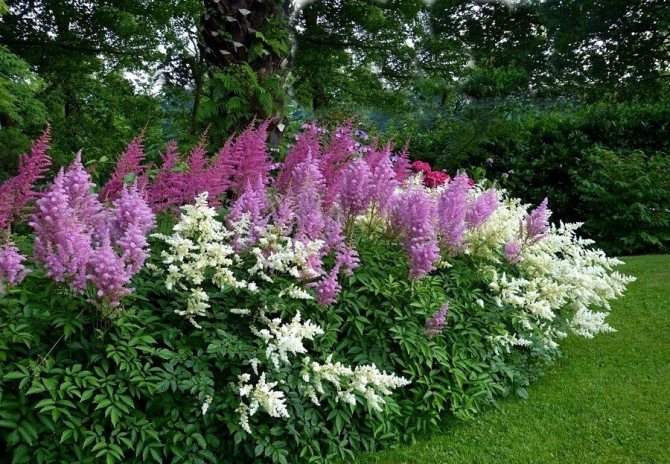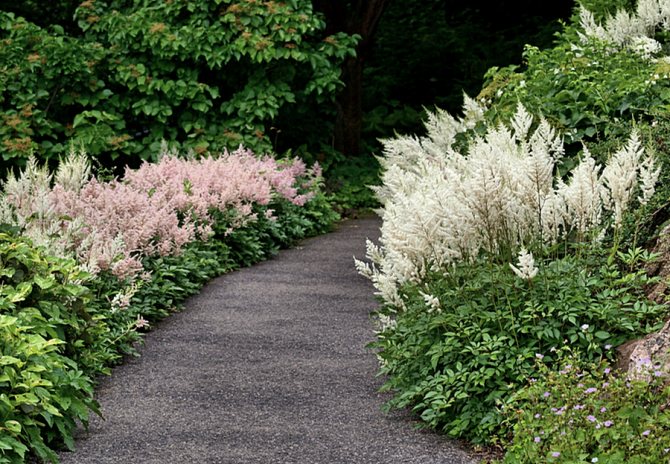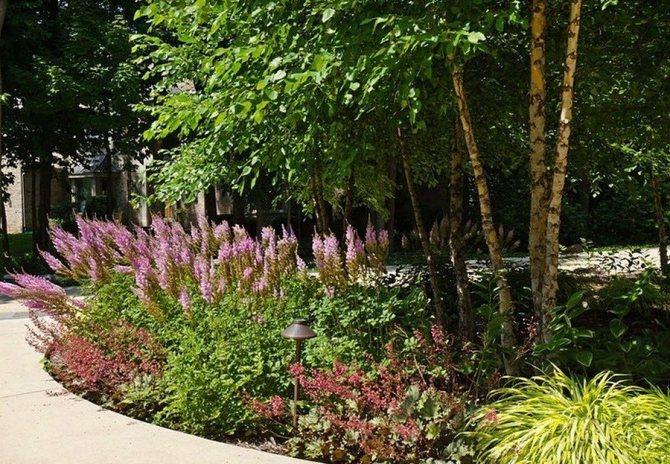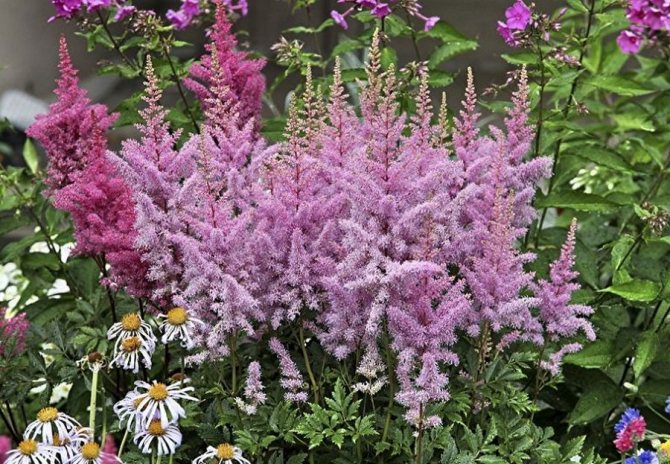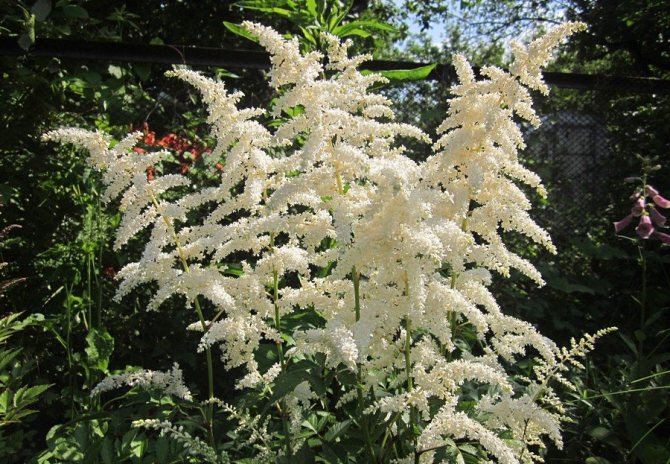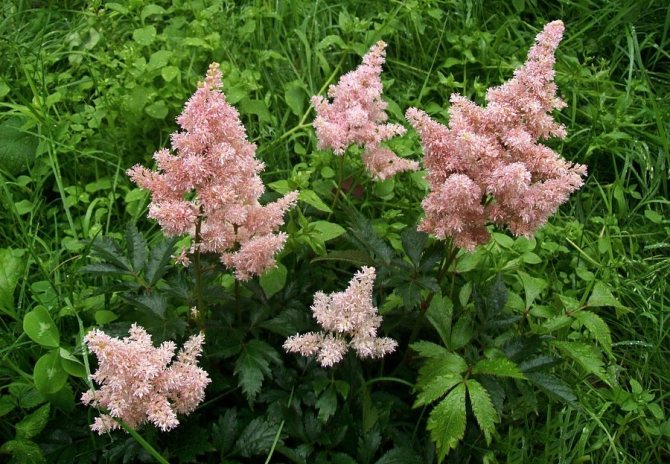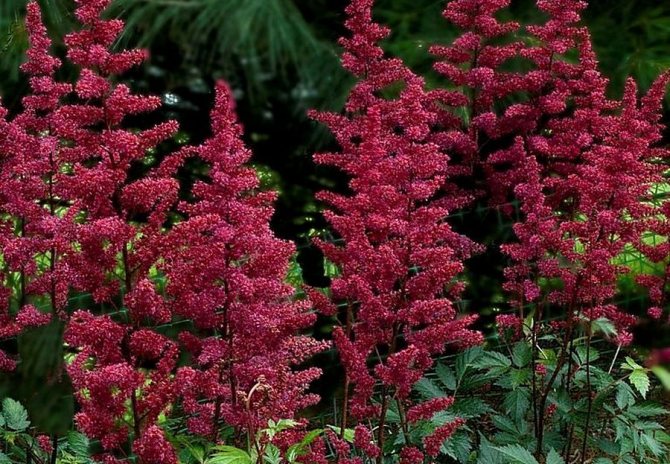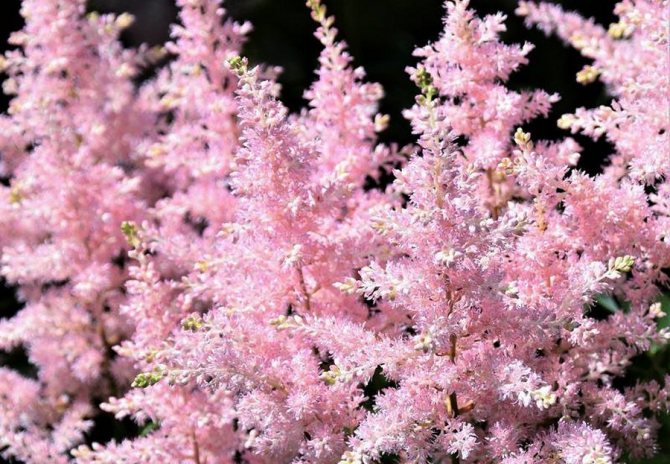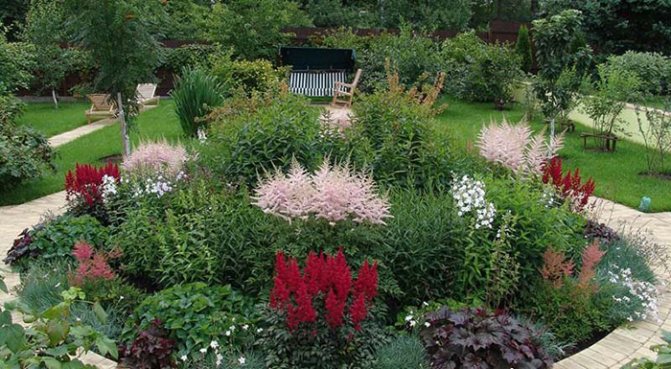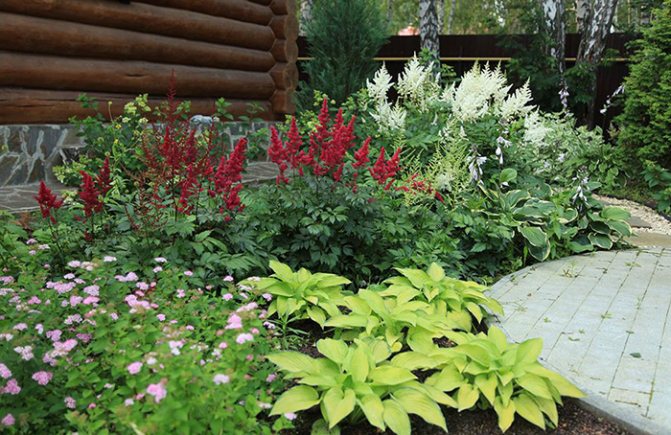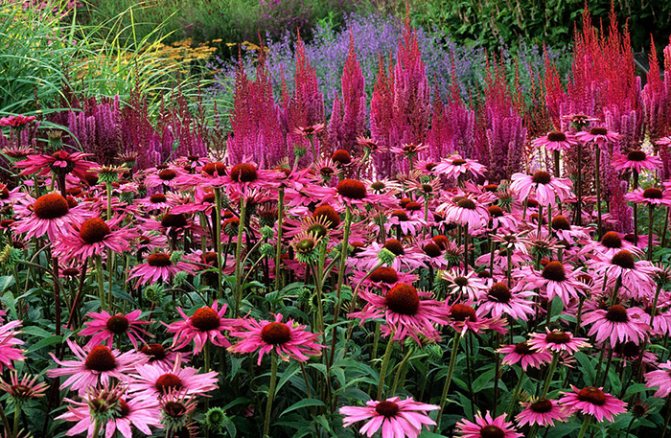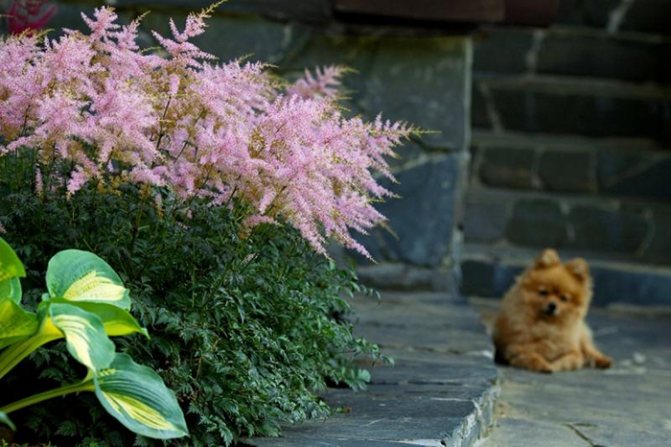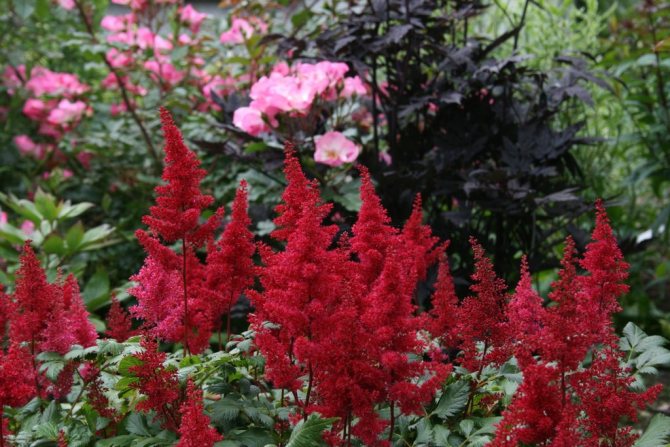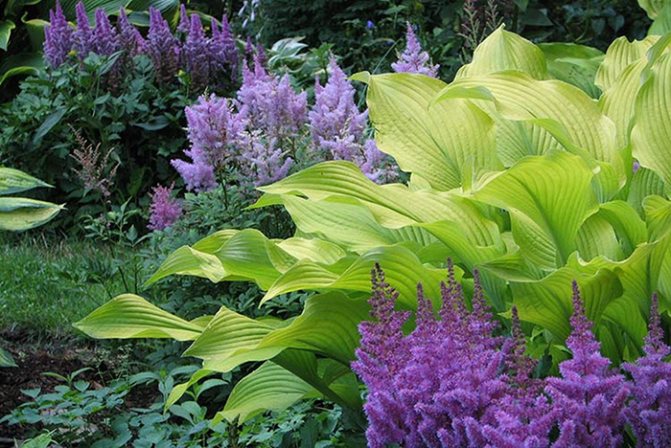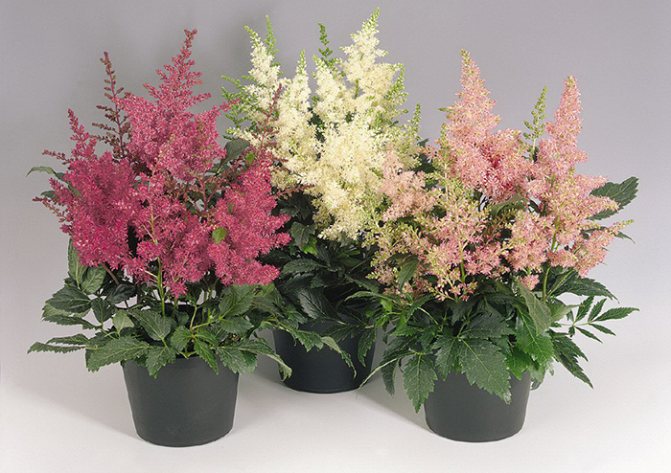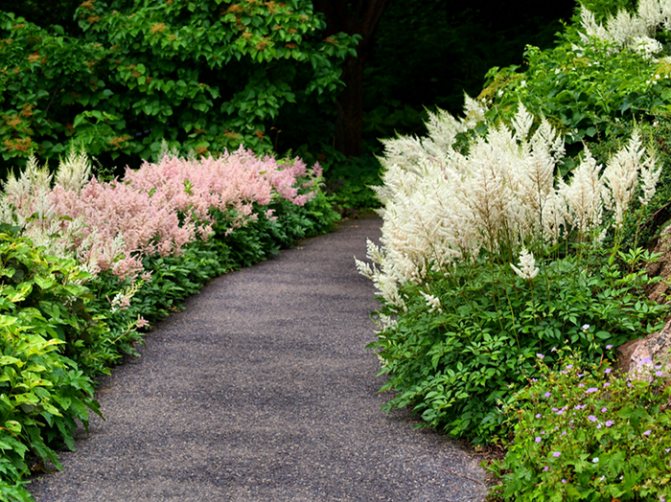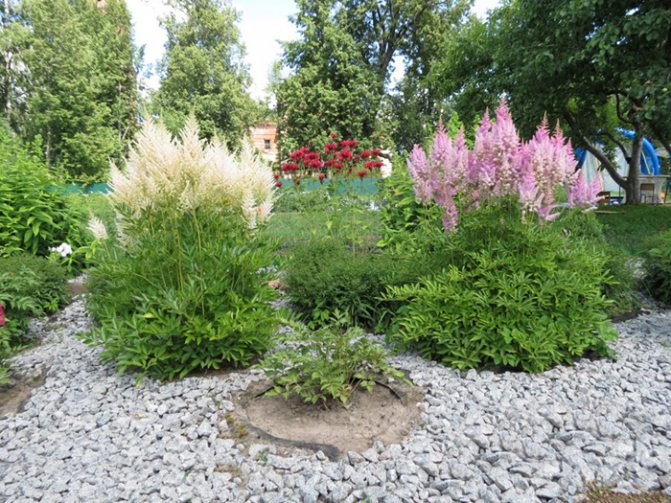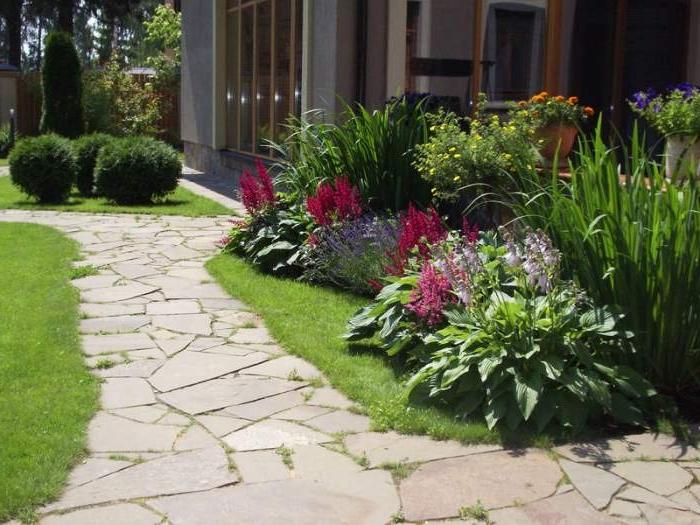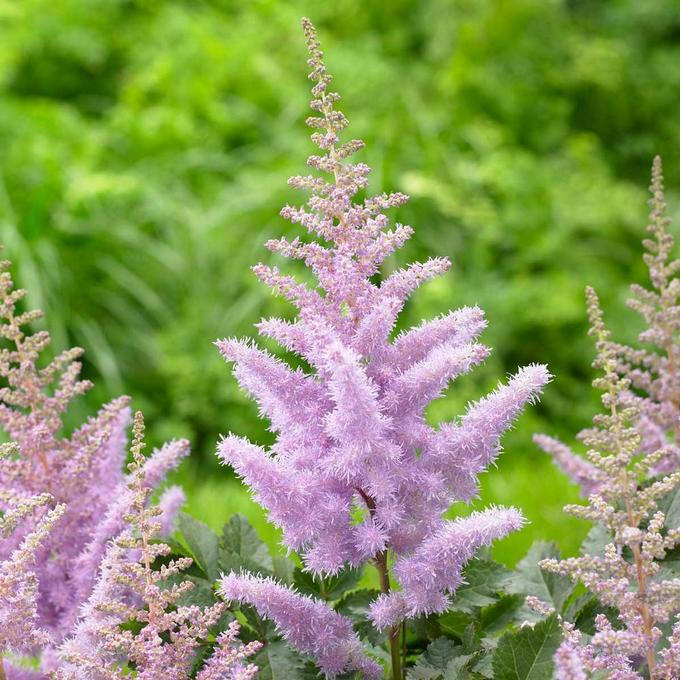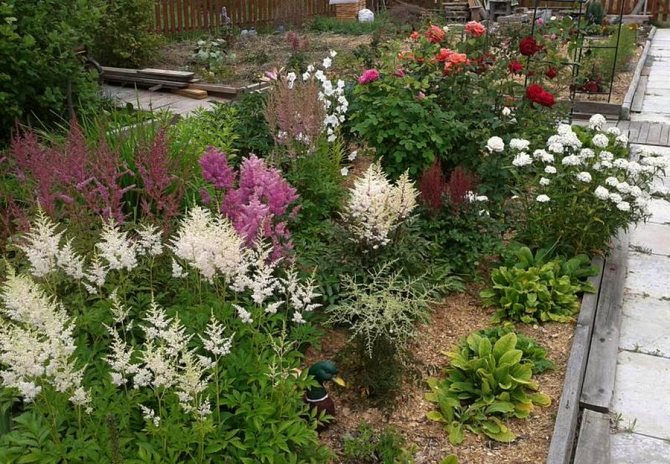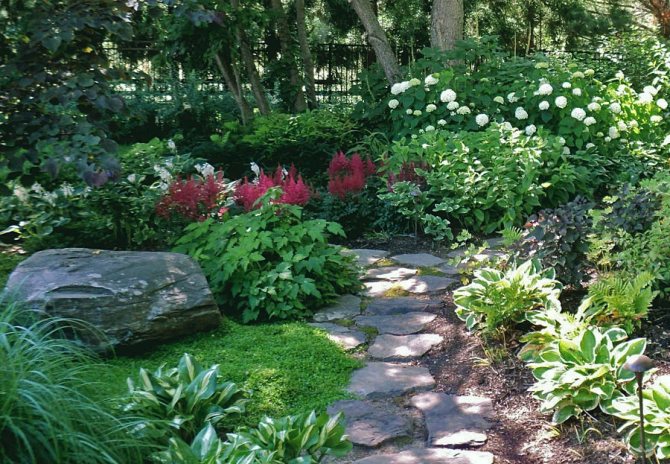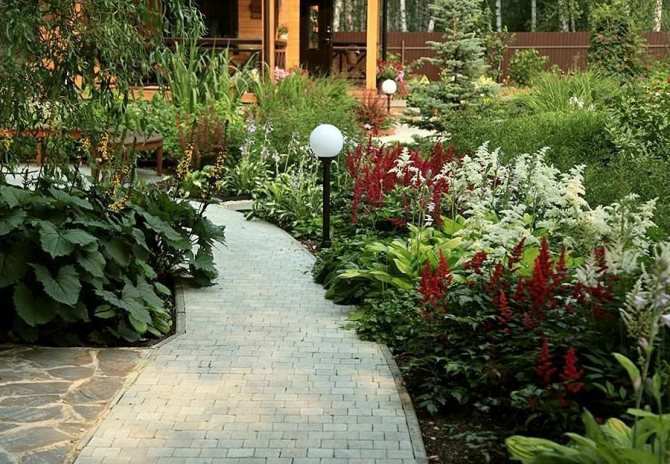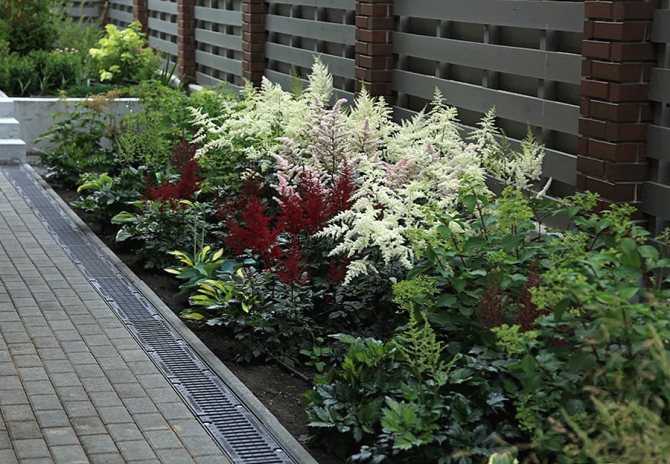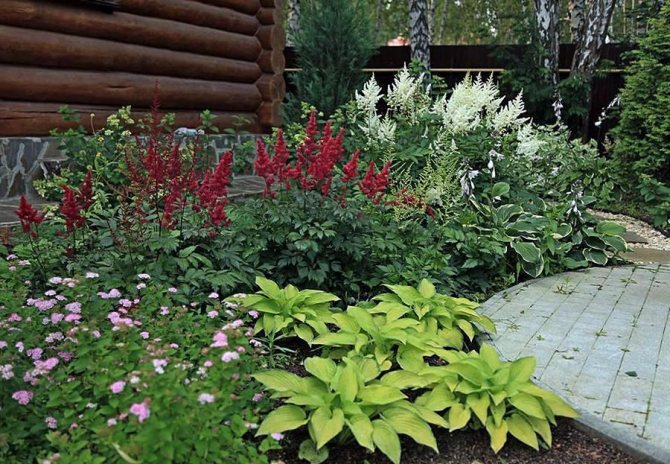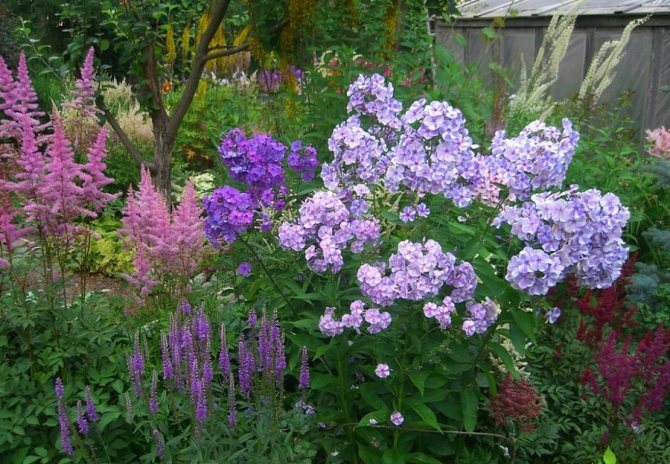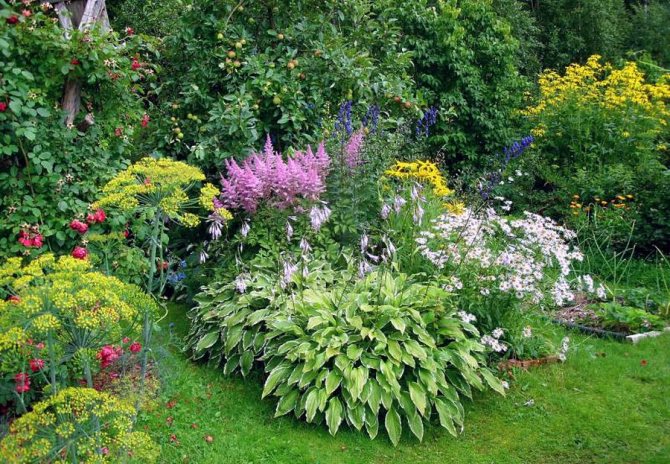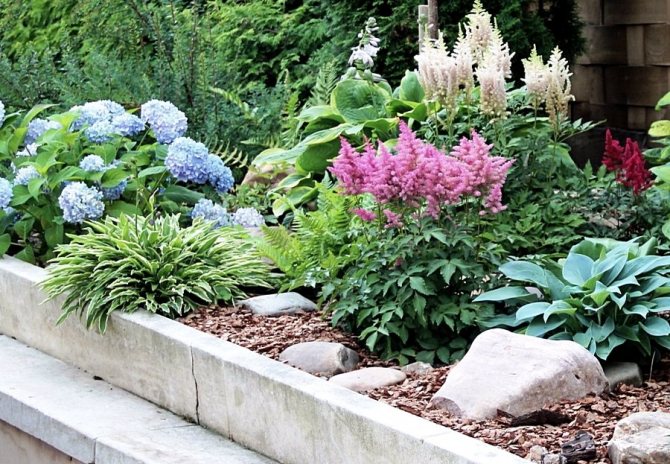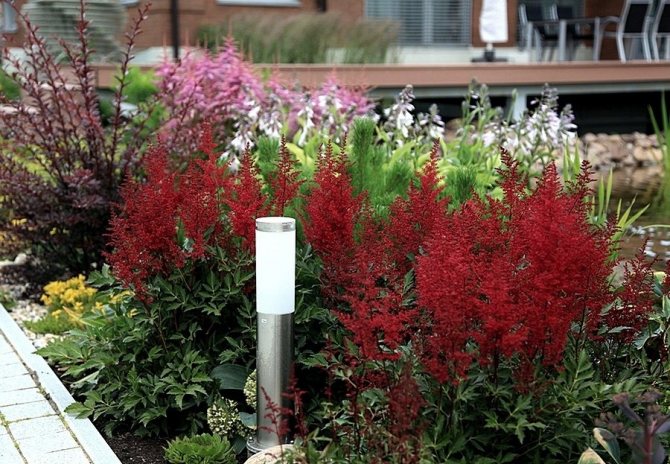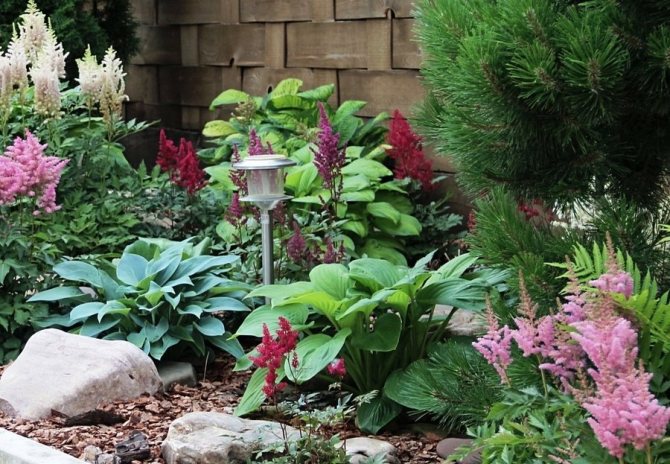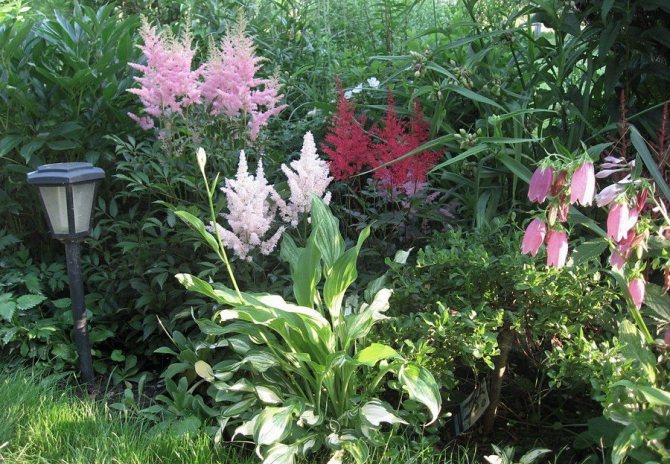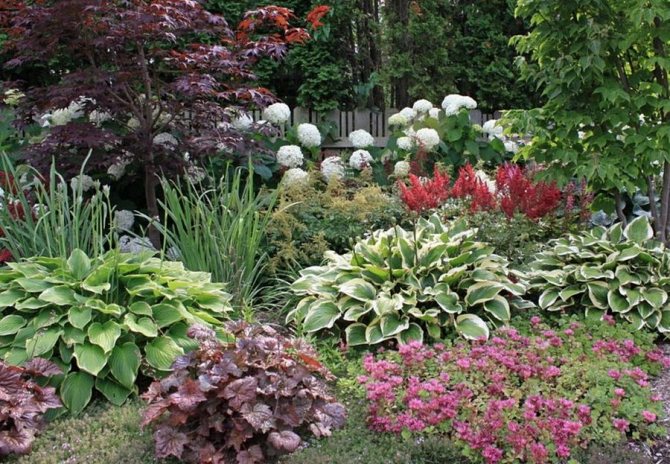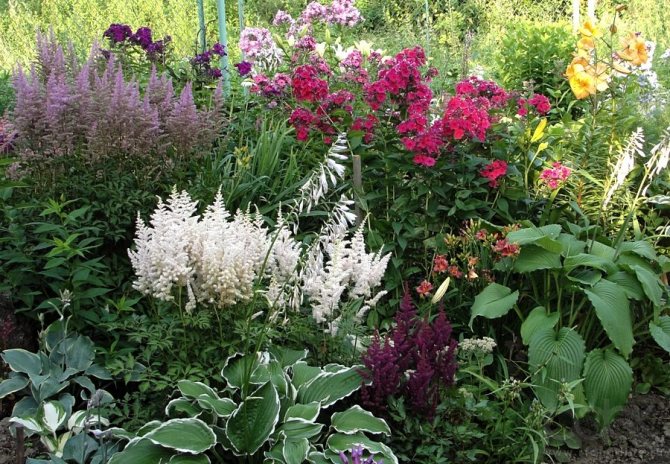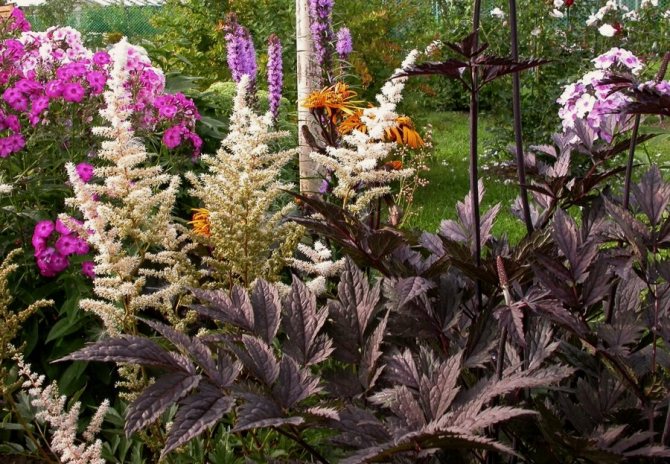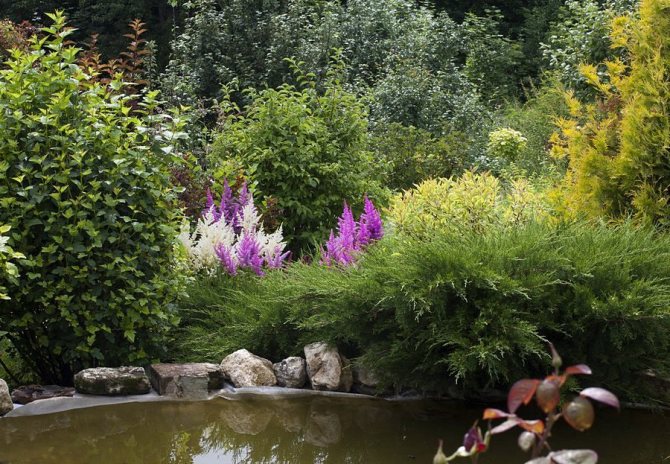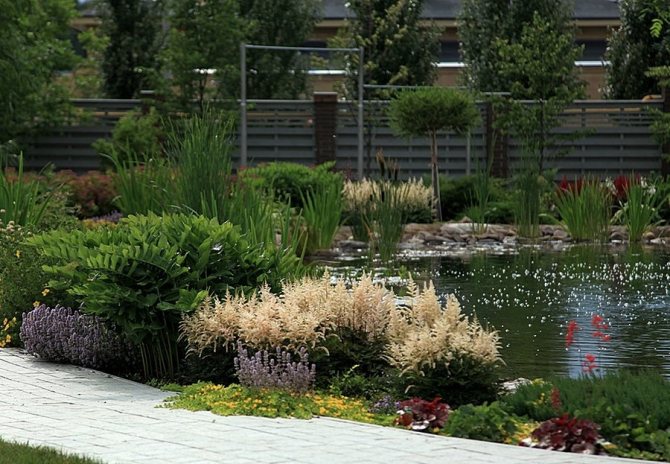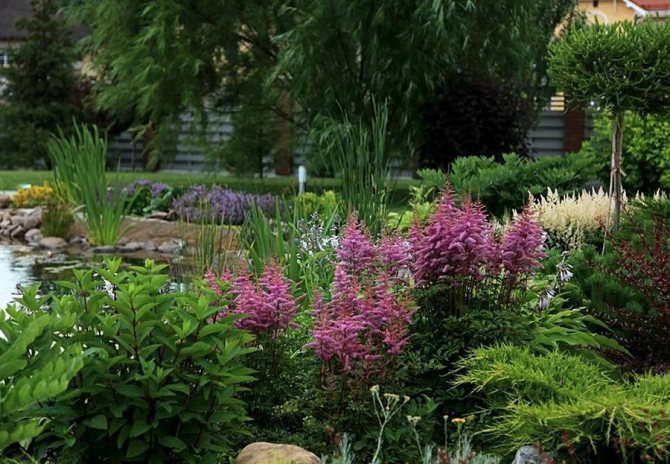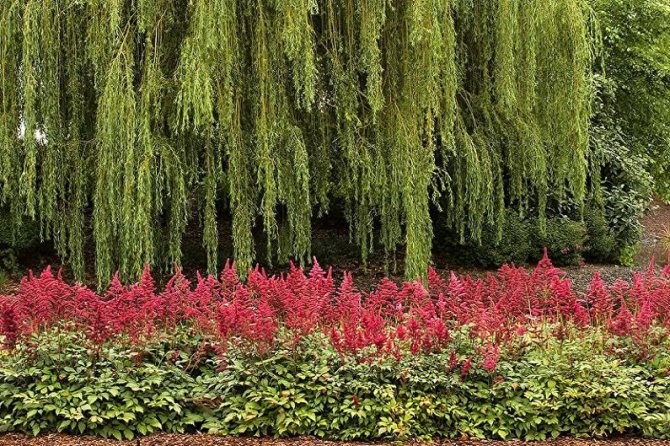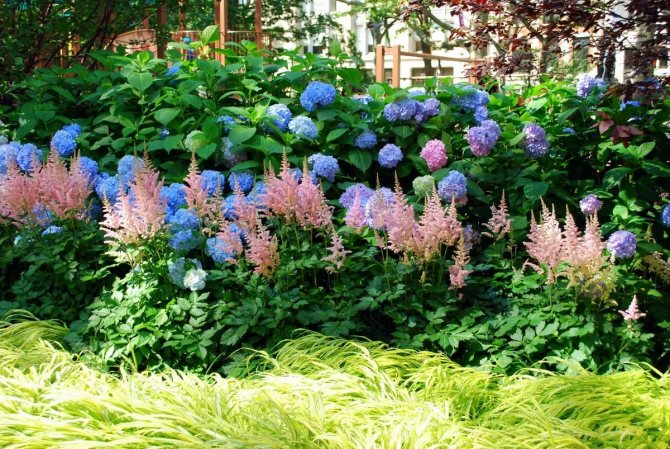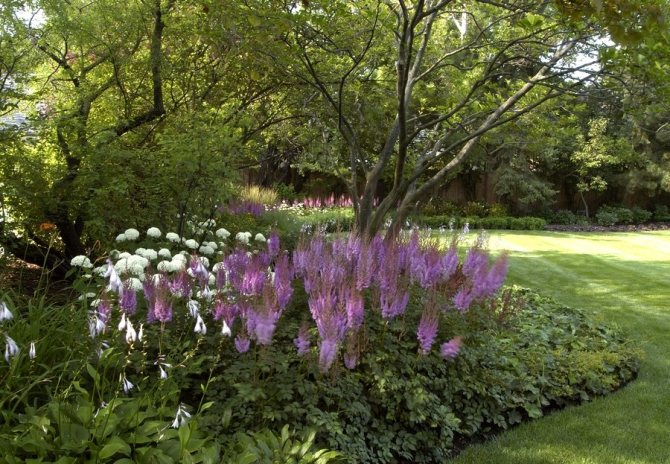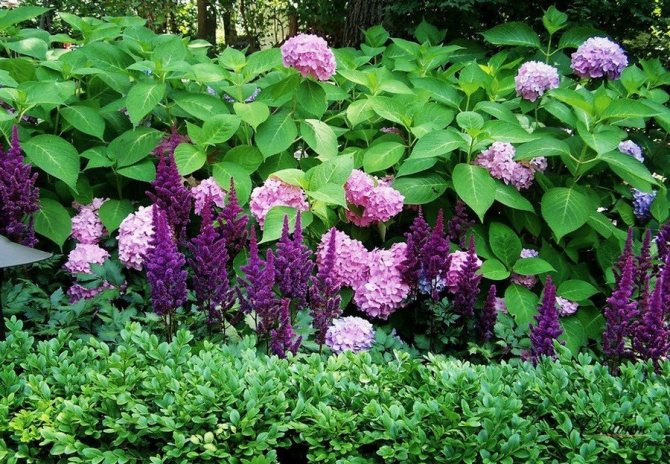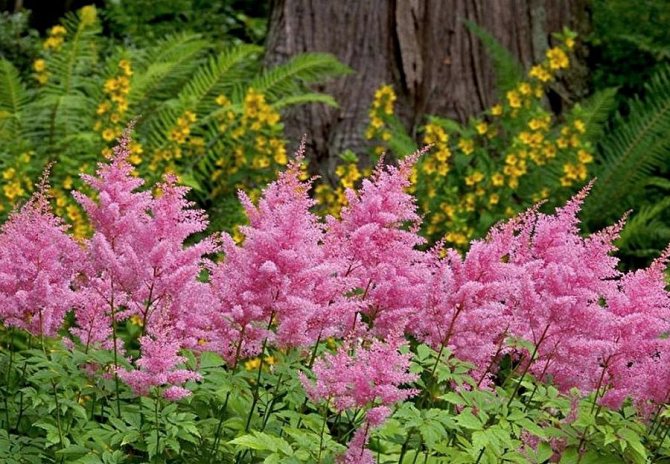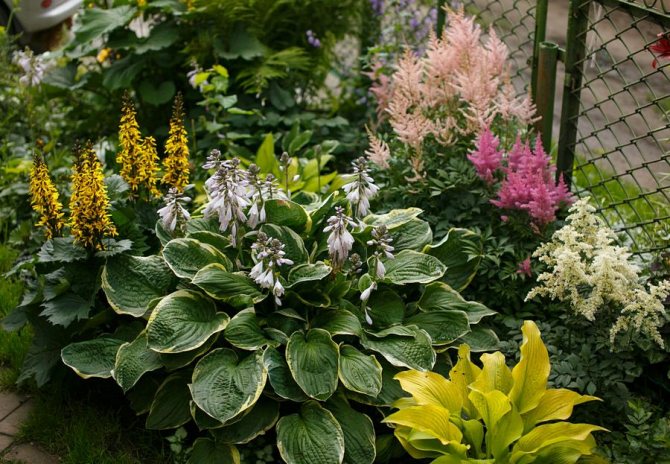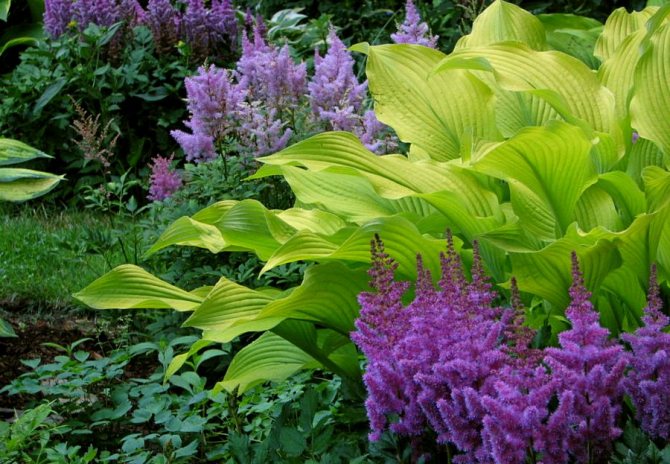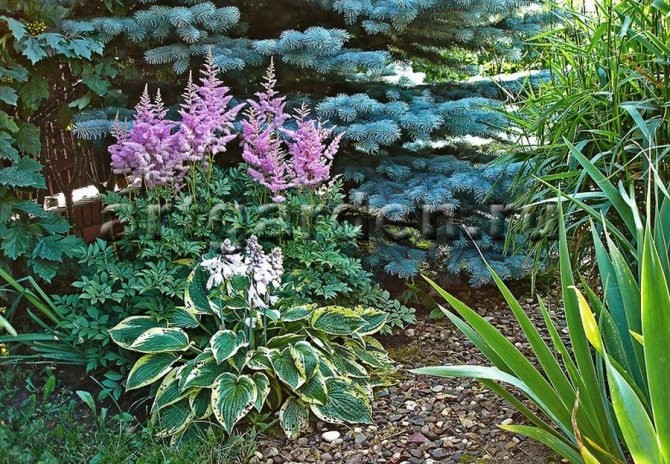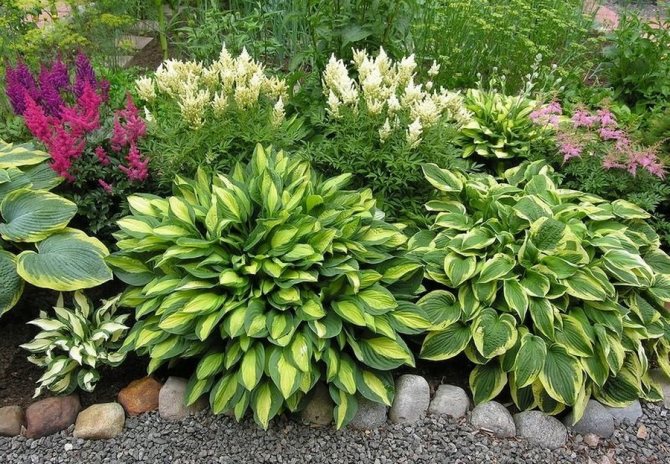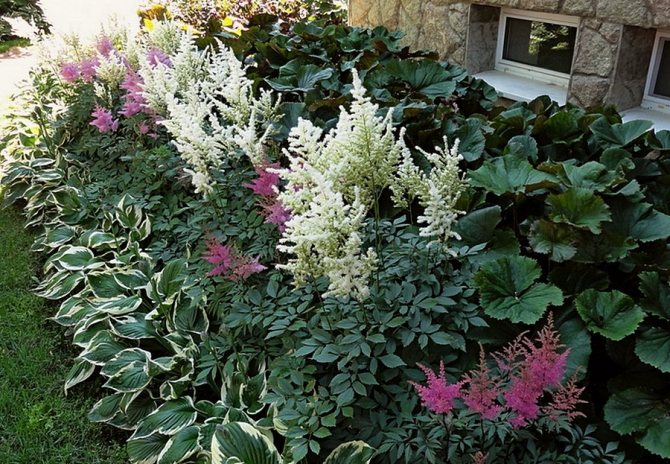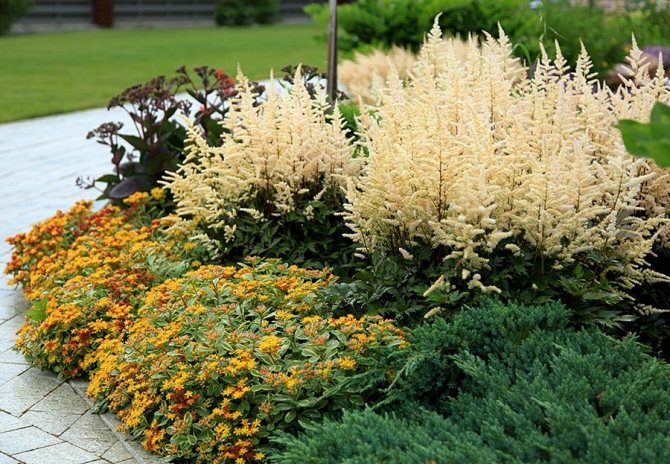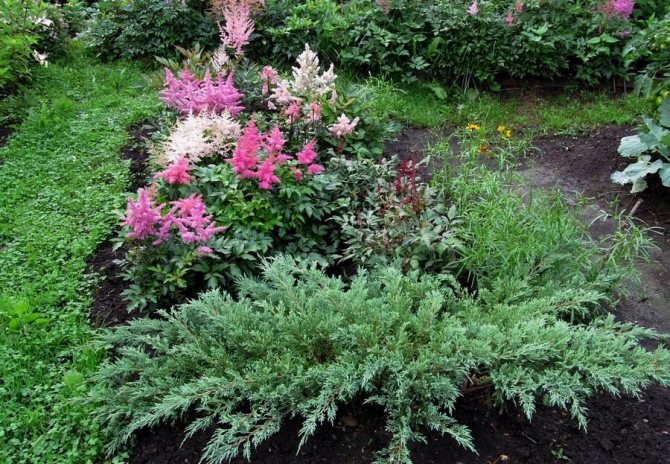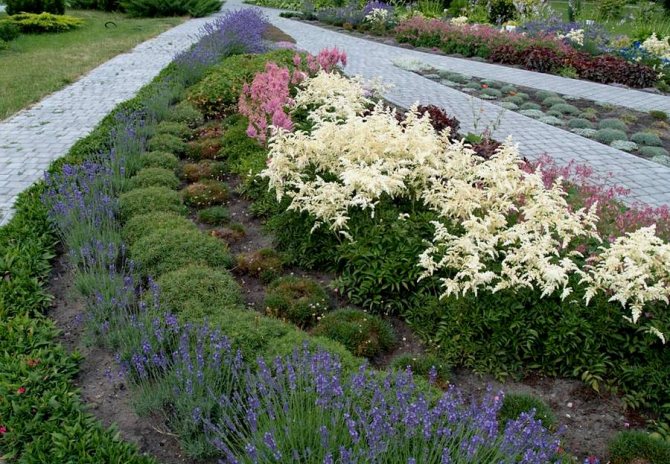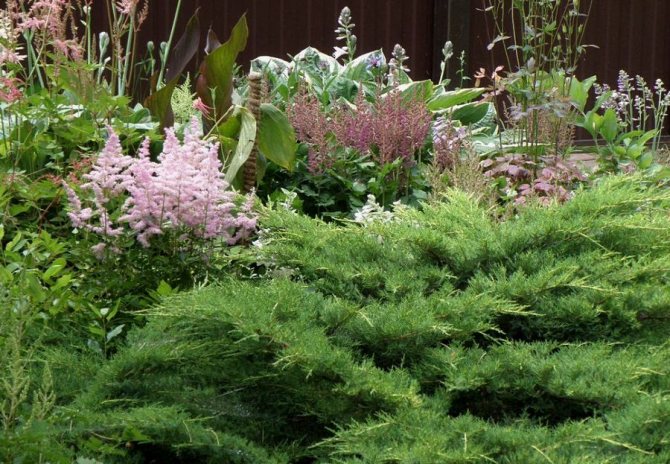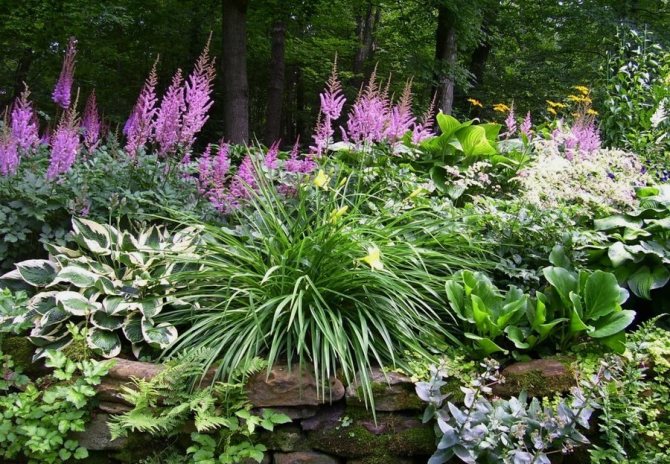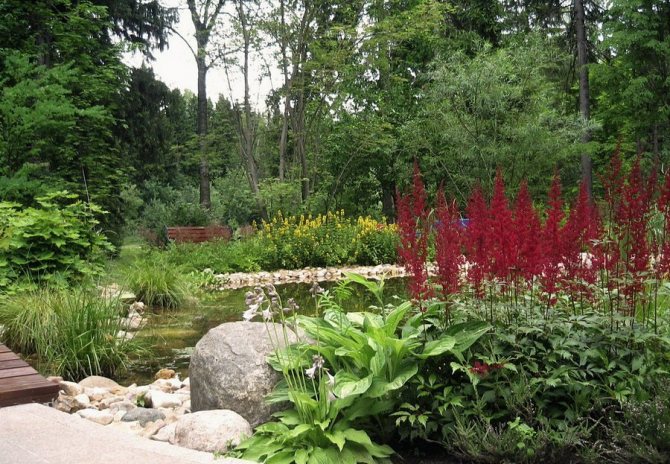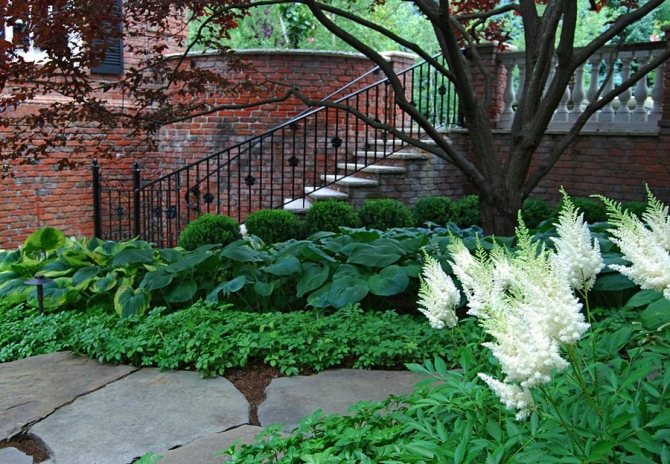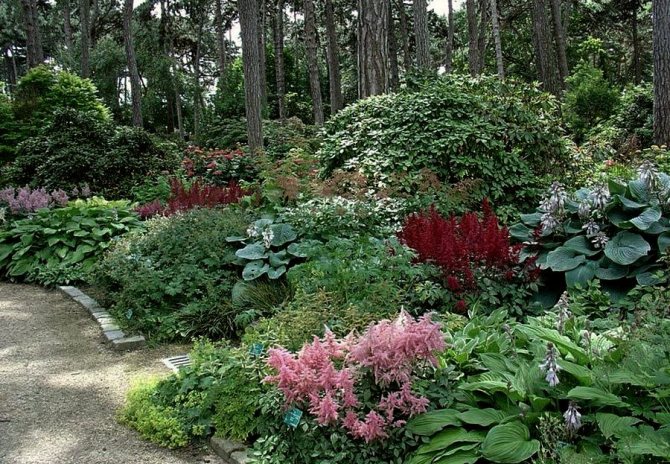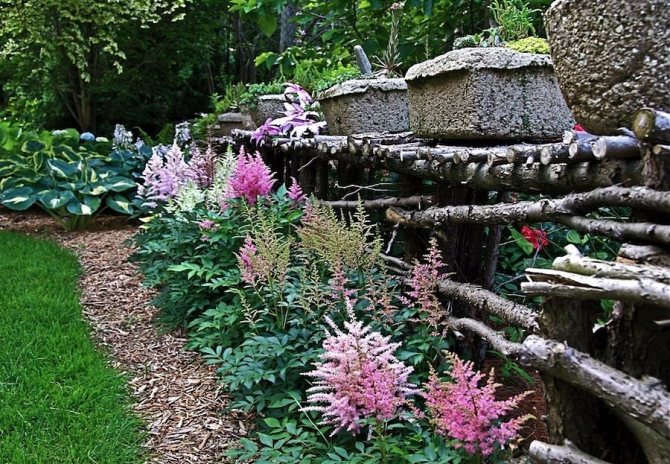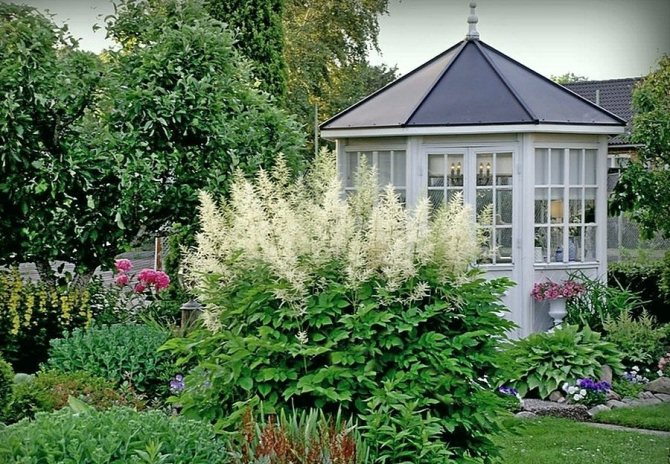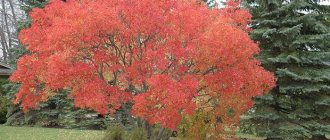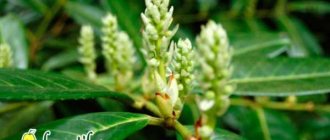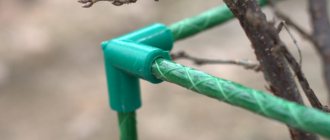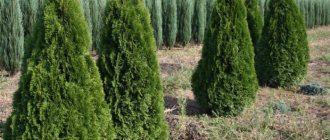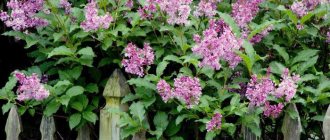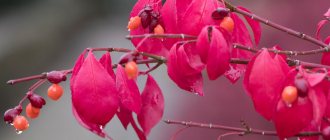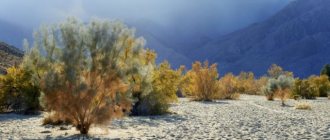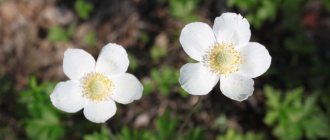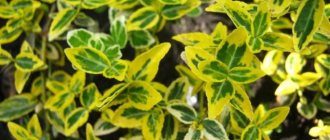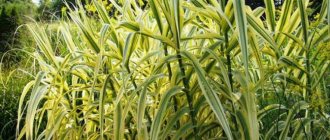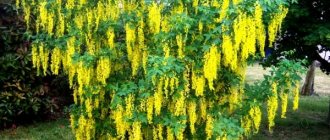Any site involves at least a small number of plants. Most owners of backyard territories prefer to decorate most of them with various greens, flowers, or lay out entire gardens. Astilba has become a very popular ornamental plant for ennobling the territory.
Where the plant looks best
In the wild, astilbe can be found in dense deciduous forests and along the banks of water bodies. It perfectly tolerates moderately moist soil and shaded areas, which allows this plant to be planted near an artificial lake and in gardens with tall trees and shrubs.
This amazing plant, in addition to luxurious forms, also has several colors, which allows you to decorate almost any flower bed or lawn in various styles and directions. The range of astilbe shades is small:
- white,
- soft peach,
- pink,
- lilac,
- rich scarlet.
But this does not bother landscape designers who invariably use the plant in their projects.
Here are some planting options with this flower, as well as combinations of astilba with other plants.
How astilba is grown
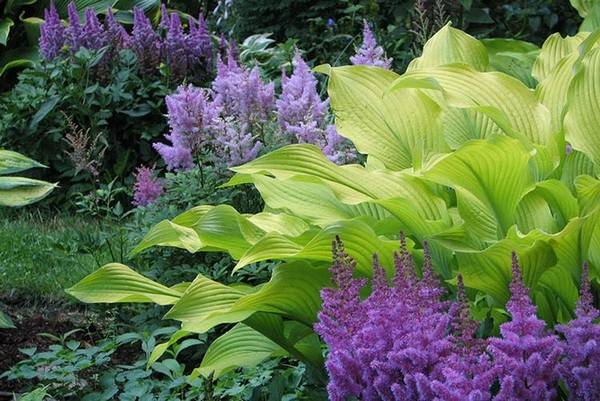
This plant belongs to perennial crops, astilba can grow quietly in one place for five years without requiring transplantation and division. The total life span of the bush is ten years, after this period, the bush must be divided and new shoots are planted.
The flower reproduces in several ways:
- dividing the bush;
- cuttings;
- seeds.
Most often, the first method is used. An overgrown bush, which has bloomed in the same place for several seasons, is carefully dug up along with the roots. After that, the flower, along with the root system, is divided into several parts using a shovel or knife.
The divided parts are planted in a new place, observing an interval of at least 35 cm.After transplanting, astilba must be watered daily until the bushes take root in a new place.
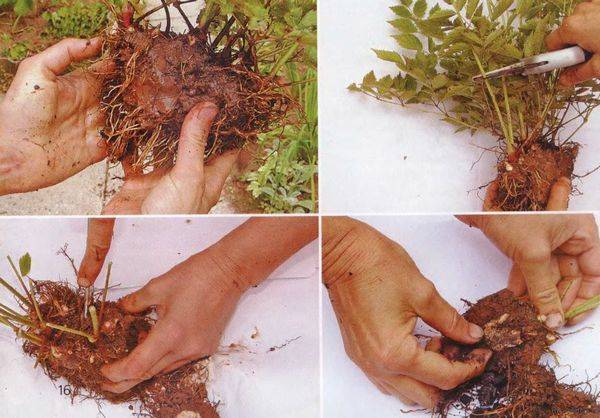

Although the propagation of astilba by seeds is possible, in practice this method is used very rarely. Indeed, for this method, the seeds must first be sown in neutral soil, without dropping them. Place the container with seeds in a room with a low temperature (from -4 to +4 degrees) for several days. Then bring it to a warm place and water in a timely manner.
The grown seedlings are transferred to a permanent place, but astilba will begin to flower no earlier than in three seasons.
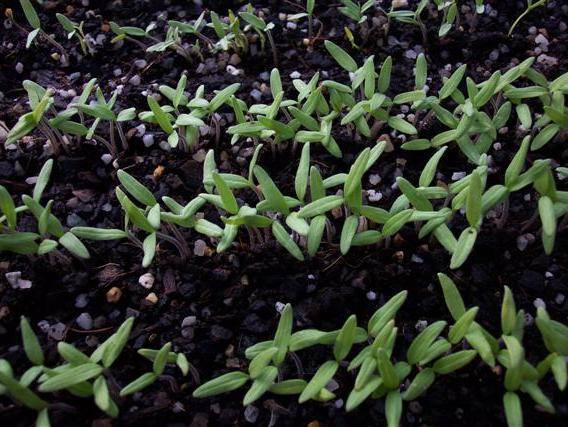

Advice! Astilbe cuttings can be ordered by mail. This flower is so "tenacious" that if the cuttings dry out on the way, they can be brought back to life. To do this, the shoots of the bush are soaked in a growth stimulator, after a couple of days they will "come to life" and will be ready for planting.
Astilba on roadside flower beds and borders
The tall fluffy astilbe, planted along the garden paths, looks impressive and original both in the company with other flowers and shrubs, and among the plantings, consisting exclusively of its different subspecies and varieties.
Care tips and secrets
To minimize the care of this flowering crop, it is enough to follow a number of simple recommendations:
- During the growing season, feed with complex fertilizers.It is possible to provide the root layer of the soil with the required volume of nitrogen, potassium and phosphorus when digging in the spring, making at the rate of 30g / sq.m. In mid-July, they feed with potassium nitrate (2 tablespoons per 10 liters of water) and the last feeding after flowering is completed with superphosphate, distributing it at 20 g per bush.
- Carry out timely watering. The moisture-loving plant does not tolerate long-term drought. On hot summer days, it should be watered up to twice a day. The culture especially needs increased watering during the period of inflorescence formation. It is better to water astilba in the early morning and after sunset.
- Mulch the soil. Mulching the planting area with bark or shavings will help keep the soil loose and reduce moisture loss. Mulch will keep the ground from overheating in the summer and freezing of the roots in the winter months.
- Rejuvenate the bush every five years. The ability of the rhizome of a plant to quickly build up mass requires periodic rejuvenation of the bush. At the end of each season, the bare rhizomes must be sprinkled with fresh soil. Otherwise, young shoots bulging out by old roots become bare and dry, which, in turn, negatively affects the quality and duration of flowering.
- Fight pests. Nematoda and slobbering penny are the main pests of the plant. They infect the leaves and rhizomes of the plant, provoking its wilting and death. You can get rid of the nematode only by completely destroying the affected specimen. It's a little easier with a penny. You can try to destroy its larvae mechanically, without injuring the roots and stems, or using garden chemistry: confidor, aktara, karbofos.
- After flowering, cut off the peduncles. But some gardeners, on the contrary, leave the dried stalks uncut, so that they decorate the spring garden for as long as possible.
- Cover the plant for the winter. In winters with little snow, the bulk of the varieties of this flowering culture freeze slightly. To prevent this, before the onset of cold weather, the stems are cut to ground level, the bare roots are mulched with peat and covered with spruce branches.
In the future, the strengthened plant will carry out weed control on its own - its powerful roots do an excellent job with this task.
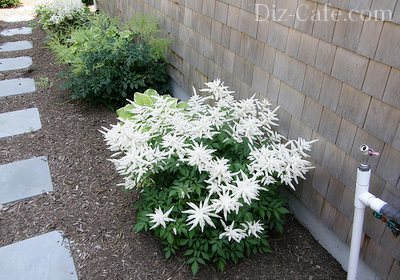

It is necessary to weed this moisture-loving beauty only at the beginning of its growth at the stage of growing rhizomes and green mass
Finally, we suggest watching an interesting video about the autumn pruning of astilbe:
Astilba in mixborders
The spreading panicles of astilba effectively complement flower and shrub crops in mixed compositions.
A few more examples of the use of astilba of different varieties and hybrids in landscape design.
Recent Entries
6 rare tomato varieties of 2020 that will bring you a decent harvest 5 cucumber hybrids that I will plant this year without hesitation 8 budget tips for summer cottages that will save money and time
As mentioned earlier, astilba loves moist soil and therefore can be planted near small bodies of water.
When decorating a landscape, it is necessary to take into account the compatibility of plants. Astilbe is especially expressive in tandem with hosta, barberry, spirea, fern and juniper.
Astilba: shade or sun
What to plant next to the hydrangea and in front of it "at the feet"
When growing, the question arises: what does Astilba like - shade or sun. She prefers shade most of all. If you plant it in the sun, then the flower will dry out and you will have to water it more often, as well as mulch the soil. Often the reason why the leaves of a plant curl is direct sunlight. You will have to make more effort so that it grows in the sun and does not dry out.
The distance between astilbe plants when planting
In order for the plant to please with a beautiful flowering, it is necessary to observe a certain distance between the bushes when planting. Low-growing species must be planted at a distance of 30 cm, and tall ones - 50 cm.
Astilba bushes near trees
Astilbe looks advantageous in the shade of the crown of large deciduous and coniferous trees, against the background of large and medium-sized shrubs.
Growing conditions for Astilba
The best conditions for growing this plant are a combination of shade and moisture. It is in such conditions that astilba feels best. Therefore, the most suitable soil for a plant is loam. Most often, Astilba is planted from the north side in order to avoid exposure to the scorching sun. The plant can also be grown on the sunny side, but in this case it will have to be watered much more often and it will bloom about 10-15 days less than grown in the shade.
Every year, this plant is best sprinkled with fertile soil, since there is a possibility that the root of the flower will be bare, which can lead to the drying out of the astilbe or, for example, to its frostbite in winter.
You should also transplant the bush about once every 4-5 years, otherwise you simply cannot avoid its aging, which leads to a more sluggish flowering.
Astilbes and hosts
Tall slender astilbe is well combined with hosts with wide bright leaves. These plants complement each other very beneficially.
Varieties and varieties of a flower
Thanks to extensive selection work, varieties of various hybrid groups of astilbe with inflorescences of different colors from white and yellow to red, bright lilac and even blue have become available. Regardless of the variety in care, astilba is considered a fairly unpretentious plant.
The most popular varieties:
- David... A spreading bush 1.5 m high, decorated with wrinkled leaves with brown veins, delicate lilac flowers. Blooms in August.
- Chinese astilbe. An early variety that blooms in early summer with lilac, pink, white small flowers, collected in inflorescences. Plant height reaches 1 meter. Basal leaves are large with fluffy red hairs. There are undersized varieties that grow well in sunny places. The most beautiful varieties are considered to be Astilbe chinensis taquetii “Purpurlanze” lilac, pink Astilbe chinensis “Vision in Pink”, Astilbe chinensis (Pumila Hybrida) “Vision in Red” dark purple.
- Japanese astilba... White, pink inflorescences that appear earlier than other varieties, bright green leaves adorn any garden until late autumn, keeping an extraordinary decorative effect when dry. Bushes are low. Most of the varieties were obtained thanks to the works of G. Arends. New varieties are characterized by resistance to cold weather, high survival rate after planting in different climatic conditions. This is Deutschland (Astilbe japonica Deutschland) with white flowers, a very beautiful pink Rhineland (Astilbe japonica Rheinland), pale lilac elegant Europe (Astilbe japonica Europe) and, finally, Astilbe japonica Montgomery with panicles of bright red, burgundy color ...
- Naked Astilba... Miniature variety only 12 cm tall with bronze leaves.
- Thunberg. Snow-white beauty, 80 cm high, with complex jagged leaves. The length of the inflorescences reaches 25 cm.The width is 10 cm.
- Common astilbe. Small plants can develop, bloom beautifully only in partial shade. This must be taken into account when choosing a place for its planting. Delicate inflorescences give it a special airy look. The most original varieties of this species are Praecox Alba with white loose inflorescences, pinkish Bronze Elegans candles, which got its name for the bronze shade of the leaves, coral Straussenfeder 90 cm high, white Professor van der Wielen from Thunberg hybrids.
Tandem with juniper
Against the background of coniferous juniper, astilba looks especially exquisite, drawing the eye and being a bright accent in the composition.
Examples of the design of naturgardens and park areas.
Astilba is one of those flowering perennials that requires little maintenance and, most importantly, can survive cold winters outdoors. No wonder this beautiful plant is deservedly popular with gardeners and landscape designers.
Flower care
The culture is considered unassuming, but this does not mean that astilbe does not need any care at all. This statement is partly true only for those flowers that are planted in moist soil in areas where coolness and shade prevail for most of the day.In such cases, the owner of the garden will only have to monitor the state of the peduncles, remove wilted inflorescences in time, and plant the bushes.
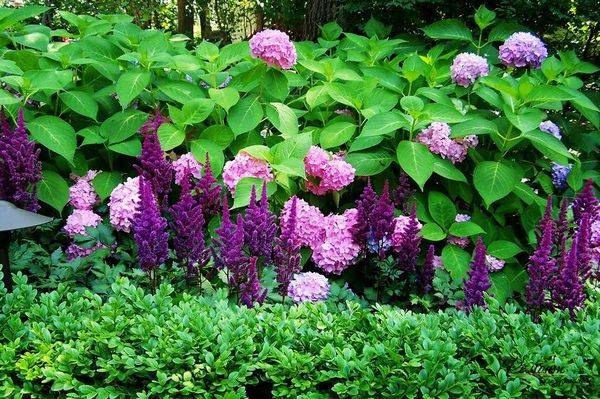

In general, the rules for caring for astilba are as follows:
- Planting a bush on neutral loose soils. If the soil is dense, it must be mulched with peat, you can mix the soil with sand or sawdust. The acidity of the soil for astilba should be neutral.
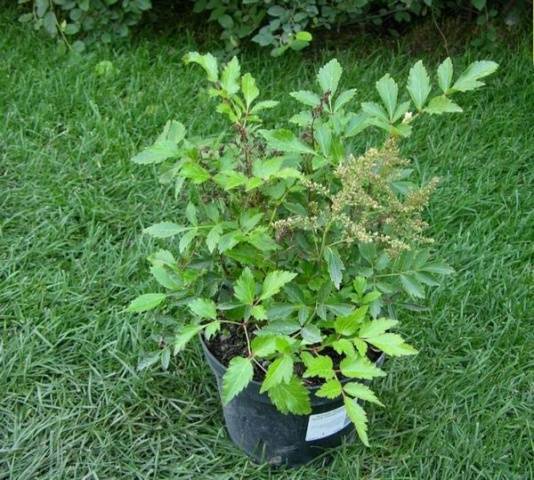

- Regular watering of the bushes. Astilba is a moisture-loving plant, even in wet areas located close to water bodies, this culture must be watered regularly. Flowers planted on the sunny side of the garden sometimes have to be watered twice a day. This is best done at sunrise and sunset.
- Mulching will help preserve the moisture and looseness of the topsoil for a longer time. Sawdust, peat, pebbles are suitable for these purposes. As a last resort, you can use grass cut from the lawn or last year's bushes of the same astilbe.
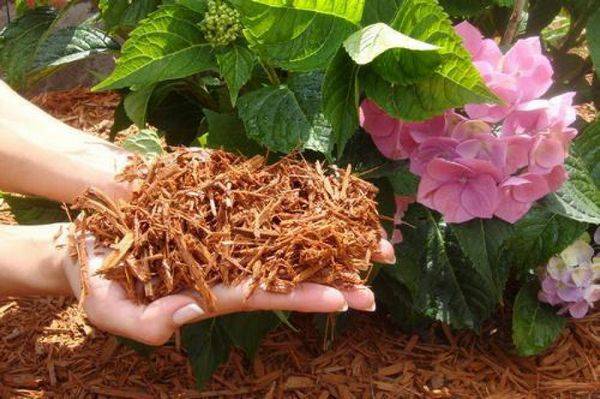

- The flower, as a rule, does not need weeding at all. Its root system is so strongly developed that the weeds next to astilba lack moisture and nutrients, they simply die. For the same reason, flowers do not need to be planted in close proximity to trees (there should be an interval of about two meters), otherwise the tree will not allow astilbe to develop normally.
- Nutrition is very important for this flower. As fertilizers for astilba, you can use phosphorus, potash, calcium-containing mineral or organic fertilizers. It is better to feed the bushes twice a year: in spring and after flowering. Without nourishment, the bushes will be weak, the flower stalks are rare, because the plant is very powerful, it needs "strength".
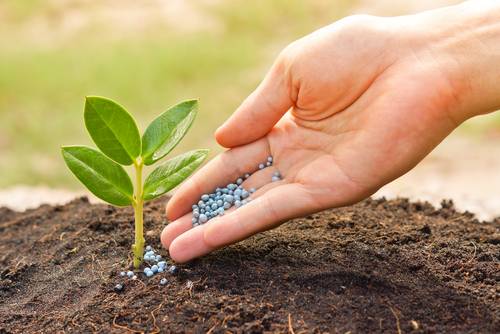

- Astilba usually tolerates winter well, even in severe frosts, the bushes do not need to be covered with insulation. But in the northern regions of the country, it is still better to cover the shrub with spruce branches and cut off all the greens from the bushes in the fall. In warmer regions (in some European countries, for example), astilbe greens decorate flower beds and lawns even in winter.
- After wilting, it is better to cut the flowers, this will enhance the development of the root system and greenery. Some designers leave shriveled inflorescences, even in this form, they are an excellent decoration for the garden.
Landing rules
The optimal period for planting falls in late spring - early summer. A flower from the south side is not planted, moreover, they choose a place for it in the shade. Otherwise, the variety will still adapt to the abundance of light, but will stop flowering faster. The presence of an artificial reservoir nearby will be a plus. The soil is loamy, with a high groundwater table. Another important factor is soil acidity, which directly affects fertility. An indicator of 7 pH is considered neutral, everything that is higher is alkaline, and closer to 5 is acidic. A slightly acidic indicator (5.5-6.5 pH) is chosen for the plant. Site preparation consists in digging and fertilizing it. The place is carefully weeded, and then the soil is fertilized with manure. Two buckets per square will be sufficient. Planting holes are dug up to 30 cm in depth, they are poured into each with a little wood ash and mineral fertilizers. Before planting, cover the hole with a thin layer of earth, preventing the roots from burns. The pits are watered abundantly. After planting, the soil is covered with peat.


Seed planting
The method is suitable for breeding new ones and allows you to grow already known varieties. Sowing begins in early March with the preparation of a special soil substrate. To do this, mix peat with sand in the same amount and put it in a deep container. Cover the mixture with a small amount of snow, and spread the harvested seeds over the surface. Its melting will be accompanied by moistening of the soil, saturation of it with microelements and the seed will naturally sink inside.


And after the snow has completely melted, they wrap the container in a bag and leave it in the refrigerator for several weeks.The seeds do not reach until the seedlings appear. After that, the seedlings are removed to a warm (+ 18 ... + 22 ° C), well-lit place until 3 leaves appear, and then they are seated separately. Watering is carried out with a syringe at the root. Otherwise, there is a risk of damage.
Diseases and pests
In the middle lane, there is a relatively small variety of insects that can harm the culture (only 3). The rest of the pest populations are common in the homeland of astilba. In order to prevent the appearance of unwanted guests, they get rid of weeds in time and do not make dense crops. If it was not possible to avoid pests, then immediate measures are taken to remove them.
The slobber lays the larvae in the leaf sinuses, and soon foamy lumps appear there. The leaves from this wrinkle and become spotty, then the bush itself withers. To combat the penny, both folk and chemical methods are used.
The lumps are sprinkled with wood ash, thus, destroying the larvae inside, or they resort to such means as karophos or aktara.
Strawberry nematode damages almost all parts of the plant - buds, leaves and flowers. Subsequently, they undergo deformation and acquire undesirable brown spotting, while the development of the bush slows down significantly.
Growths on the surface of the roots are considered a sign of the presence of a gall nematode; it is inside these formations that the pest lives, even though it is small in size. In the second growing season, the nematode becomes easily visible. At first, they slow down the development of the bush, and after a while they completely lead to its death. As a preventive measure, they try to examine the plant more often, with symptoms of the disease, the perennial is destroyed. Timely weeding is carried out, especially during the first growing season. They are processed with Fitoverm.

